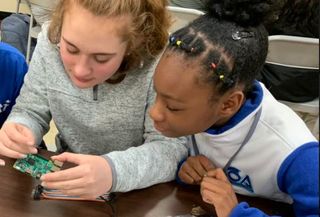Dr. Karee McAndrew would like more girls to code and pursue careers in tech.
To that end, McAndrew, director of technology for the Bayonne Board of Education in New Jersey, has helped bring a successful girls coding club to her district. For these and other efforts, including helping to increase tech literacy among district students, parents, and staff during the pandemic, McAndrew was recently honored with the Innovative Technology Director award at the Tech & Learning Innovative Leadership Awards in New Jersey.
McAndrew began her professional career working for MTV as a web designer and video editor. Although she loved the work, she soon realized that a corporate job wasn’t for her and took advantage of New Jersey’s alternate teaching route option – getting her certificate as she taught. She was ultimately drawn to the tech side of teaching and later got a masters in education, followed by a doctorate in curriculum and instruction.
She offers tips for encouraging girls -- and all students -- to code.
1. Encouraging Girls to Code: Offer Afterschool Programing

A few years ago McAndrew helped her district partner with Girls Who Code, an organization dedicated to closing the gender gap in tech through many efforts, including education. Now each of Bayonne’s schools has a Girls Who Code club that meets after school. “We have a huge turnout in them -- 10,15, 20 girls per club,” McAndrew says.
The clubs are able to get this level of student engagement thanks to strong district level and teacher support. Many of the club leaders are computer science teachers who are able to recruit kids from their classes.
Girls Who Code also offers engaging curriculum and other fun incentives for members. “When kids sign up, they send them little swag bags, and the kids get tons of cool freebies like t-shirts and other things like that,” McAndrew says.
2. Remember Representation Matters
“Being a female in the computer science realm, director realm, there aren't many of us, it is a very male-dominated position,” McAndrew says. “So I think anytime that you are able to see other females who have already stepped into the role, it gives you that idea that like, ‘Oh, I can do that too.'”
In order to do this, McAndrew encourages educators to show their students others who look like them in prominent programing and tech positions. Girls Who Code resources are very helpful with this but McAndrew also recommends Amazon’s Future Engineer program. “They do an excellent job making sure that they represent all genders,” she says.

3. Teach Students How Broad Coding Is
The Girls Who Code curriculum is designed to help show young women that the field of coding is much more diverse and is involved with more industries than they may realize. In addition to tech-specific jobs, coding can be the starting point for other career sectors.
“It'll focus on female engineers, it'll focus on female jobs that maybe you wouldn't necessarily think would fall under the computer science realm, but do,” McAndrew says. “So it gives girls that view to say like, ‘Oh, wow, the look at all these great females and what they're doing and how successful they are. And they followed the path of computer science or science to end up in the position that they are.'”
4. Make Coding Fun and Inclusive

While Girls Who Code clubs focus on recruiting young women to coding, the clubs are open to boys and nonbinary students. It is all part of McAndrew's and the district’s efforts to make coding inclusive and engaging. Another key ingredient in these efforts is student enjoyment.
“We make the curriculum a lot of fun,” McAndrew says. “We buy really great robotics programs that kids just love to play with – doesn't matter if you're male or female. And we also use really great coding programs that are fun for all ages. Any time coding activities have challenges and you can get rewards, even if it's at the digital store within the platform, kids get motivated. So we always try to make sure that everything that we do is fun, engaging, and the kids do see an end result that's rewarding for them.”

